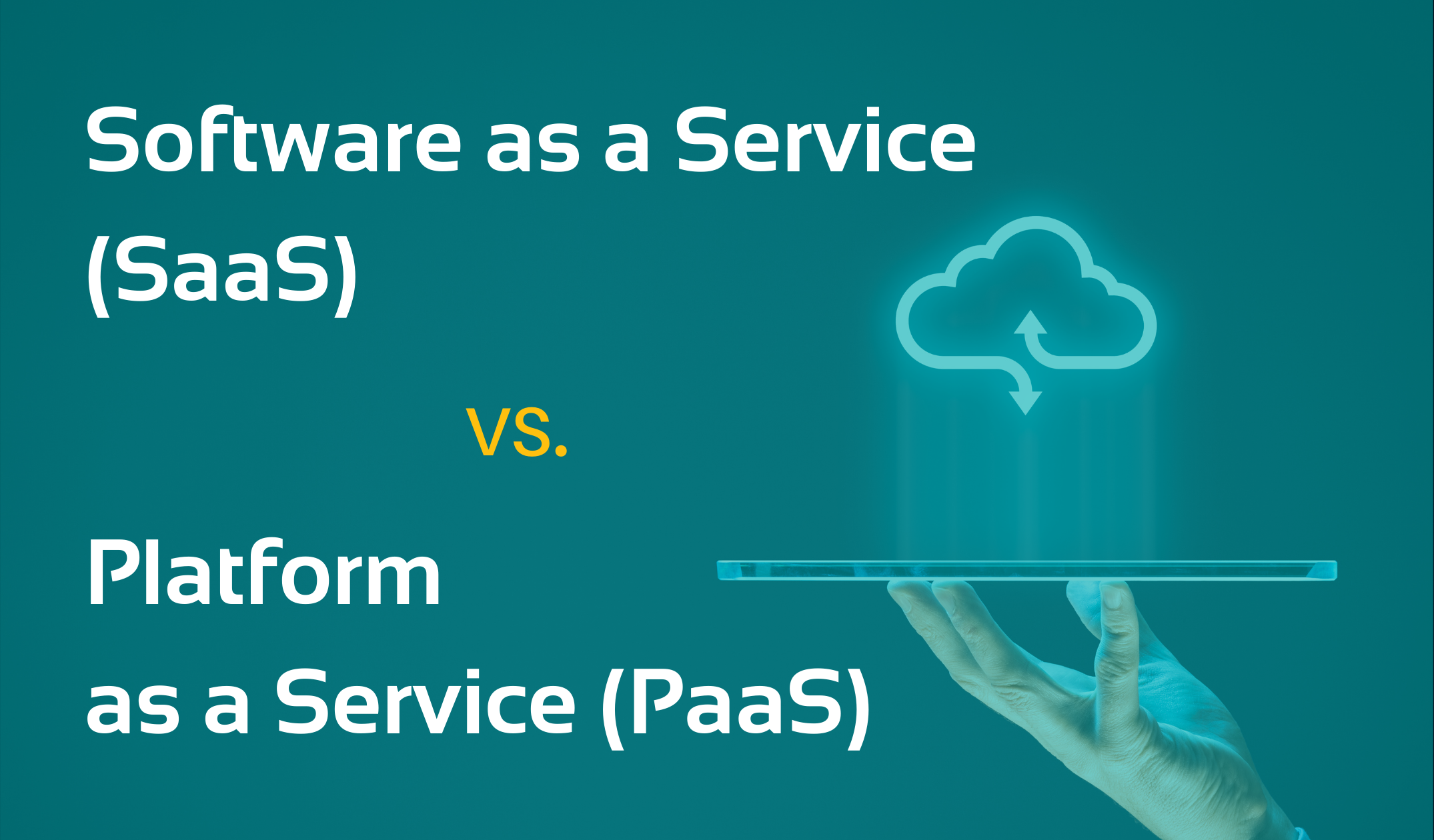 This installment of the miniseries: SaaS Versus . . . will dive into the similarities, differences, advantages, and disadvantages of Software as a Service vs Platform as a Service—SaaS vs PaaS.
This installment of the miniseries: SaaS Versus . . . will dive into the similarities, differences, advantages, and disadvantages of Software as a Service vs Platform as a Service—SaaS vs PaaS.
Definitions:
Software as a Service (SaaS) is a cloud-based method for delivering software applications to consumers
Platform as a Service (PaaS) is a cloud-based method for delivering a platform upon which a developer can build custom applications and other software to consumers.
Similarities: SaaS vs PaaS
Clearly, the two are derivatives of cloud computing, and they both follow the as-a-Service model described in the initial blog of this miniseries. There are few similarities between the two, but a comprehensive comparison requires recognition of how they are the same.
- Delivery of the service is executed through the internet—there is no onsite installment of hardware or software necessary for clients to utilize the vendor’s service.
- Both are scalable—common practice is for vendors to create several packages that include a varying number of features or services with tiered pricing: the more features or services the more expensive the package and vice versa.
- Internet delivery allows the vendor to provide wide-spread accessibility to their clients—not only can the software or platform be accessed from anywhere as long as there is an internet connection, but multiple users (the minimum-maximum number usually defined in the package offering) can be given access without tedious downloads and installs.
- Subscription-type payments are standard for most SaaS and PaaS vendors—rather than pay an installment and purchase fee all upfront, the client will pay for implementation or activation upfront and sign an extended contract in which they will make monthly payments for the service they’re receiving.
- Vendors retain ownership of the software or the platform and therefore retain the responsibilities for managing and maintaining them—the client has little to no responsibility for technical advancement or repairs to the services they purchase.
On a basic level, it’s unsurprising that the two share these specific similarities, but as the details emerge it will be clear that even in their similarities the two execute their process in significantly different fashions.
Differences:
The contrast should be more apparent now that you know the similarities. Pinpointing how the two differ from one another on both a small and large scale will give roots to the discussion of their advantages and disadvantages.
- Provided Services—the most obvious of the differences. SaaS vendors provide their clients with fully functional software complete with full-service management and maintenance. PaaS Venders provide their clients with an environment for building custom software as well as software tools for developing, testing, and deploying the application according to BCM. PaaS manages and maintains the platform they provide, but they do not have any involvement with or responsibility for the applications built on by the client on the platform.
- Responsibilities—this is the most common comparison that people discuss in respect to SaaS, PaaS, and IaaS. Where the responsibilities lie for each party differs greatly in a SaaS situation vs a PaaS Situation. With Software as a Service the vendor retains all responsibility for the product they are providing to their consumer. SaaS vendors resolve all technical difficulties, manage all advancements, and maintain everything within the software. A PaaS vendor, on the other hand, only performs these responsibilities for the platform—any software application built on the platform must be managed, maintained, resolved by the developer(s) who built them.
- Payment—although both SaaS and PaaS usually follow a subscription-type payment model where the client makes reoccurring payments on an established schedule, the type of reoccurring payments differs. SaaS payments are usually fixed while PaaS payments may fluctuate. PaaS vendors often use an additional payment model in which the customer pays per use. Each PaaS vendor will determine how they calculate use, but ultimately the client will only be charged for what they used during the specified interval between payments.
- Cost of Customization—SaaS and PaaS both have great room for customization, however extensive customization for a SaaS client will likely come at additional costs to be paid to vendor who will then allocate the staff to create or build the clients desired feature. In contrast, customization in PaaS is greatly dependent on the developers who draft and build the applications, which means it won’t (usually) come at an additional cost.
On the surface SaaS and PaaS may seem similar enough, but—as you can see—the details of the way that vendors in each arena execute their business have significant contrast. Their unique details produce unique benefits and disadvantages, which allow them to thrive.

Advantages: SaaS vs PaaS
The advantages are usually the characteristics that draw the most attention during discussion of these two variations. Although they share a few broad advantages, the differences between SaaS and PaaS make them uniquely beneficial.
SaaS:
- All inclusive: the price that clients pay for SaaS includes complete service. The vendor carries responsibility for all creation, implementation, advancement, and management so that clients can conveniently use the product without responsibility for the product.
- Course maintenance: in addition to convenience, the inclusiveness of SaaS also allows the client to maintain complete focus on their course towards reaching business goals and executing objectives.
- Budgeting friendly: most SaaS vendors charge a fixed cost for each payment made on the agreed upon schedule. This payment model makes it easier for clients to budget more accurately and reduce the risk of overbudgeting or underbudgeting which may ultimately lead to budget waste.
- Advancement Built-in: SaaS vendors must perform frequent and extensive updates to their product to avoid becoming irrelevant, which means that their clients benefit from frequent updates both small and large at no additional cost money or effort.
PaaS:
- Creative control: PaaS vendors simply provide their customers with the foundation and the tools to build. What the client builds with the provided supplies is controlled entirely by the client and their developers.
- Reduced responsibilities: if the client/developer were to have started from scratch, they would have been completely responsible for maintaining the software they built as well as the hardware, virtualization, networking, so on and so forth. According to RedHat, with a PaaS the client is only responsible for the applications they build and the data that is collected within those applications.
- Quicker deployment: PaaS accelerates the process of construction and deployment significantly. The use of a PaaS allows the client to skip the very complicated and time-consuming foundational work and jump to building the software application.
- Exclusivity: because the client controls the creation of the applications, they have the opportunity to build functionality that competitors may not have access to or be able to build. Building a solution for an industry problem will give them a major competitive edge.
SaaS & PaaS:
- Cost effective: both are more cost-effective options than their traditional counter parts.
- Highly accessible: both can be accessed from anywhere with an internet connection which allows better access to remote and distributed teams.
- Efficient: without downloads and installations these are both more efficient than their traditional counter parts as well.
- Scalable: both have the ability to create opportunities for a wide range of consumers
The advantages are probably what most people want to know when comparing the two. Clearly, they both excel in different scenarios. That being said, with advantages there always comes disadvantages and these two are no exception.
Disadvantages: SaaS vs PaaS
To bring together the picture of these two types and their comparison, it’s important to discuss the disadvantages that come with each type, too. While everyone loves to hear the advantages that something can bring to the table, they often underestimate the impact that the disadvantages may have.
SaaS:
- Customization limitations: SaaS isn’t always an ‘as is’ product, but the extent of customization will likely be limited by package offering. However, vendors are likely to offer more extensive customization for additional cost.
- No control: with no (or little) responsibility comes no control. Downtime, outages, updates, and all other things that come with Software are decided and executed on the vendors schedule. Clients are very much at the mercy of their vendors when it comes to maintenance and advancement of the SaaS.
- Lack of individuality: SaaS generally has a basic product that is built upon to create several varied package offerings. This practice may keep cost down, but it also results in a lack of differentiation. Each client may receive a custom site upon login, but at the core they are the same.
PaaS:
- Staffing cost: if your organization doesn’t have a robust existing IT staff there will be a significant amount of additional cost for staff to develop, manage, and maintain the software built on the PaaS.
- Cost fluctuation: although pay-per-use ensures that the client only pays for what they actually utilize, the uncertainty of the cost varying from payment to payment does present a risk of overspending or insufficient funds.
- Divided attention: because the development of the software is the responsibility of the client, they must dedicate a lot of time specifically to that effort, which will pull attention from other important business process.
SaaS & PaaS:
- Integration difficulties: according to BMC both SaaS and PaaS have potential complications when it comes to integration with existing tech stacks.
- Data security: both SaaS and PaaS clients have to trust their vendor with the management and storage of their data to some extent which leaves room for breaches or losses.
There is the likelihood that many of these issues may be addressed as advancements are made to both PaaS and SaaS, but that may also come with new challenges. Ultimately, as with most things, the advantages and disadvantages come down to control and cost.
SaaS vs PaaS Wrap Up
Both SaaS and PaaS reduce the responsibility that the consumer bares substantially. Both are tools that make it easier for businesses of all sizes to keep up with their competitors without breaking the bank. However, even though SaaS and PaaS can be used to achieve the same end goal, the way they are utilized to achieve that goal is entirely different. In the next installment we will dive into SaaS vs Infrastructure as a Service or IaaS before wrapping things up and taking a look at why Software as a Service was the route that Triptych took when creating this software for our clients.


 This installment of the miniseries: SaaS Versus . . . will dive into the similarities, differences, advantages, and disadvantages of Software as a Service vs Platform as a Service—SaaS vs PaaS.
This installment of the miniseries: SaaS Versus . . . will dive into the similarities, differences, advantages, and disadvantages of Software as a Service vs Platform as a Service—SaaS vs PaaS. 


